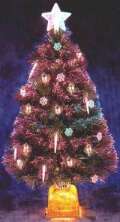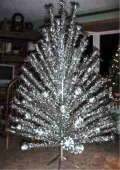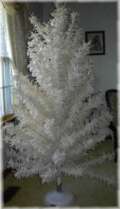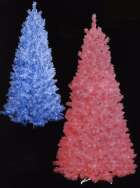
A modern goose feather tree, modeled on the 19th Century German precedents (available from David Poole Antiques).

A good example of var. fibreoptika.

A rare, 2.1 m tall Pom-Pom Evergleam tree, a classic example of forma argentea (Aluminum Christmas Trees 2002).

A fine example of ssp. electronica, forma albofloccula (Aluminum Christmas Trees 2002).

Superb examples of formae cyanoflocca (left) and luridea (right) [from www.soul-utions.com, now defunct].

A juvenile specimen, it has already borne cones - albeit they are the staminate cones of Alnus rubra [C.J. Earle at Silver Star ski lodge, Xmas 2005].

Conservation Status

Anser pseudarboris
Addis 1885
Common names
Lobby fir, Xmas tree.
Taxonomic notes
There are three subspecies: Anser pseudarboris subsp. pseudarboris, the common lobby fir; A. pseudarboris electrica, the electric lobby fir; and the extinct A. pseudarboris xyloporis, the brush fir. Subspecies electrica occurs in two varieties, the type var. electrica and the recently evolved fibreoptika. There are also several distinct formae, described below.
Description
Trees to 0.5-2.5(-7) m tall and 2-4(-10) cm dbh, with a strictly pyramidal crown of horizontal branches extending the entire height of the tree. Bark shiny green, flaking or fading on very old trees, fissured and black on trees that have experienced fire (not uncommon in old specimens of subsp. electrica). Buds absent. Young shoots steel-grey, very sharp, about 1-2 mm long. Leaves usually bright green, straight, about 2.5 cm long, square at the apex, both abaxial and adaxial surfaces perfectly smooth, with no stomata. However, in formae aurea and argentea the leaves are golden or silver, respectively, and have a filmy or metallic texture. In formae alboflocca, cyanoflocca and luridea, the leaves may be coated with a waterproof organic film that is white, blue, or pink, respectively. In variety fibreoptika, approximately 10% of the leaves are terete, linear, transparent, and 5-8 cm long. Cones are absent except in forma deluxe, in which case they are indistinguishable from the nonserotinous cones of Pinus contorta: variably asymmetric, lanceoloid to ovoid before opening, broadly ovoid to globose when open, (2-)3-6(-7.5) cm long, tan to pale red-brown, lustrous, nearly sessile. This species is readily distinguished from all other conifers by its bark and leaf characters.
Distribution and Ecology
Native range consists primarily of Wal-Mart, Sears, J.C. Penney and Target stores, but wide horticultural utilization has introduced it to many settled areas. This is the only conifer that regenerates exclusively indoors, with regeneration dependent on an obligate mutualism with specialized transnational corporations. Individuals encountered outdoors are generally senescent.
Remarkable Specimens
The largest ever recorded was in Columbo, Sri Lanka. Unveiled for Christmas 2016, it was 73 m tall and has "a steel-and-wire frame is covered with a plastic net decorated with more than 1 million natural pine cones painted red, gold, green and silver, 600,000 LED bulbs and topped by a 6-meter (20-foot)-tall shining star" (Mallawarachi 2016).
The species is highly unusual in having no xylem (except vestigial, non-functional xylem in subspecies xyloporis). Thus there are no annual rings. However, subtle annual changes in morphology make it possible (albeit difficult) to accurately date the inception of most specimens. This species evolved in approximately 1840, in a now-extinct forma originally native to Germany. That forma had foliage composed of goose feathers. The oldest extant individuals belong to subspecies xyloporis, and first established in approximately 1885.
Ethnobotany
The mature trees are occasionally harvested to manufacture tin cans, and the foliage of subspecies xyloporis was formerly employed to clean test tubes, but currently the principal use of this species is ornamental. Due to its evergreen habit, it is widely perceived as symbolic of immortal life and is used in celebration of cultural and religious festivals commemorating that theme.
Observations
Specimens can be seen most American corporate lobbies (hence the common name), and moderately large mixed stands are seasonally abundant in most American malls.
Remarks
The Trump administration has sought to have this designated as the national tree of the U.S.A.
The genus name commemorates the German trees of the 1840s, which had foliage fashioned from goose feathers (geese are in genus Anser). When I first prepared this page in 2002, those were quite extinct, but they have lately experienced a revival and are available from a variety of sources.
Citations
Aluminum Christmas Trees. 2002. Aluminum Christmas Trees. http://www.oldchristmaslights.com/aluminum_trees.htm, accessed 2002.12.04, now defunct.
Mallawarachi, Bharatha. 2016.12.25. Sri Lanka claims world’s tallest artificial Christmas tree. The Washington Post.
See also
Aluminum Christmas Trees Come To Canada, http://archives.cbc.ca/IDC-1-69-1010-5677-20/that_was_then/life_society/aluminum_trees, accessed 2005.11.22, now defunct.
The Antique Christmas Light Site, http://www.oldchristmaslights.com/beyond_the_50s.htm, accessed 2005.11.22, now defunct.
The Christmas Archives, http://www.christmasarchives.com/trees.html, accessed 2005.11.22, now defunct.
Cool Things: Aluminum Christmas Tree, accessed 2010.11.14.






